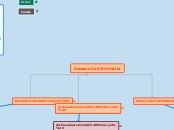Domains Of Life
Bacteria (Prokaryotic)
Do not have ether linkages like Archaea, and they are grouped into a different category, hence a different domain.Ethers are common in organic chemistry and even more prevalent in biochemistry, as they are common linkages in carbohydrates and lignin.Membranes are made of un-branched fatty acid chains attached to glycerol by ester linkages (important biological molecule)Bacteria contain peptidoglycans (a molecule composed of both protein and sugar rings) in their cell walls. However, archaea do not have this compound in their cell wallsMost bacteria fall under thishard to determine the number of themBacteria can form spores, archea cannot
Archaeabacteria (Prokaryotic)
Archaea reproduce asexually by binary fission, fragmentation, or budding; unlike bacteria and eukaryotes, no known species forms spores.Characterized by different membrane structureArchaea have more complex RNA than Bacteria.They also live in extreme conditionsArchaea evolved many cell sizes, but all are relatively small. The biochemistry is different and uniquePresence of different chemical linkages in Archaea adds to their ability to withstand extreme temperatures and highly acidic conditions, but many archea live in mild environments. (Ether Links)
Eukaryota (Eukaryotas)
Reproduce both asexually through mitosis and sexually through meiosis and gamete fusionHave membrane-bound organelles (including a nucleus containing genetic material)
Kingdoms
Test
Eubacteria
Found in soil, hot springs, radioactive waste water, Earth's crust, organic matter, bodies of plants and animals etc.Cell walls have Peptidoglycan / Lipopolysaccharide (Latter does not)Bacteria constitute a large domain of prokaryotic microorganisms. Typically a few micrometers in length, bacteria have a number of shapes, ranging from spheres to rods and spirals.Ester Linked (Key biological molecule)
Morphologies
Coccus
Spheres which can havemany different arrangements (Diagram to the left) Example: Staphylococcus aureus
Spheres
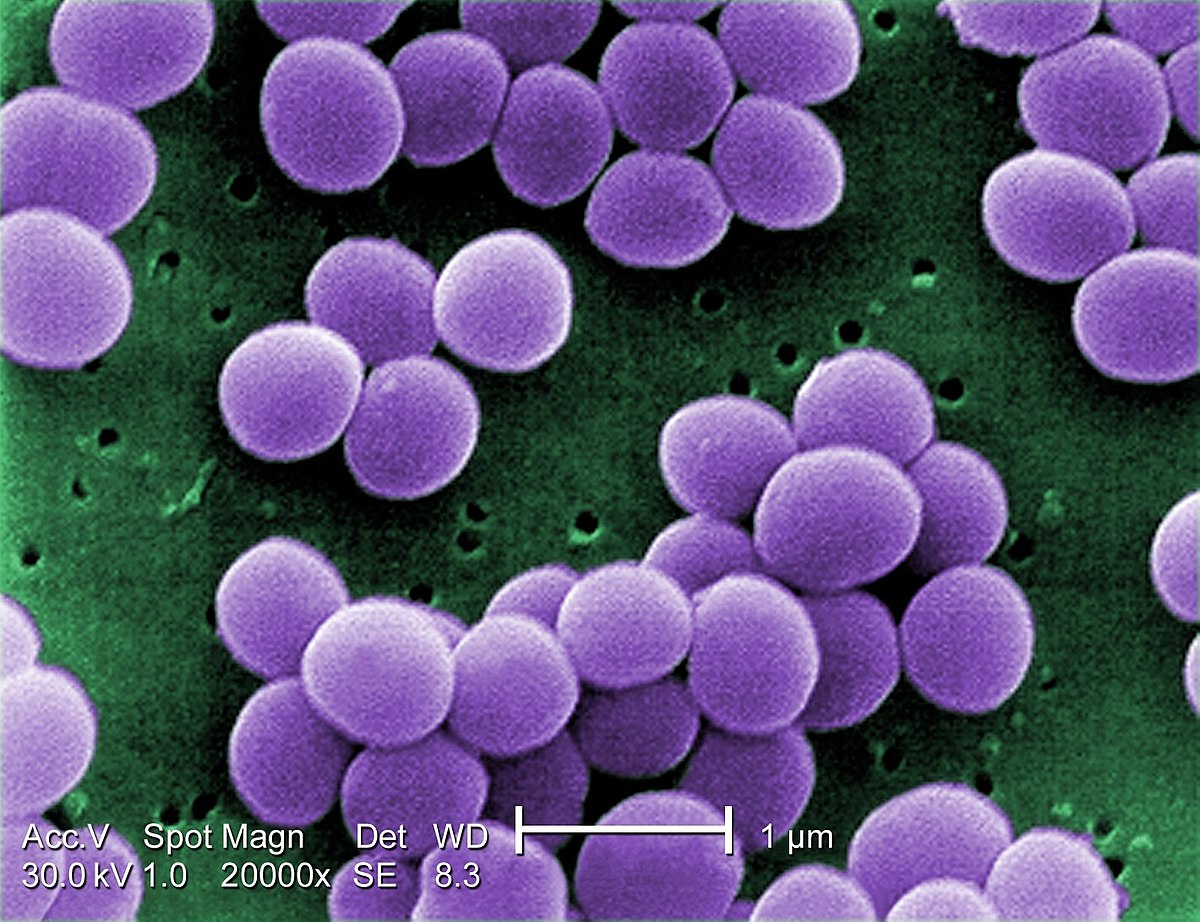
Staphylococcus aureus
Staphylococcus aureus is a gram-positive, round-shaped bacterium that is a member of the Firmicutes, and it is an usual member of the microbiota of the body, frequently found in the upper respiratory tract and on the skin. It is often positive for catalase and nitrate reduction and is a facultative anaerobe that can grow without the need for oxygen.Although S. aureus usually acts as a commensal of the human microbiota it can also become an opportunistic pathogen, being a common cause of skin infections including abscesses, respiratory infections such as sinusitis, and food poisoning
Bacillus
Rod Shaped

Hay bacillus/Bacillus subtilis
Bacillus subtilis, known also as the hay bacillus or grass bacillus, is a Gram-positive, catalase-positive bacterium, found in soil and the gastrointestinal tract of ruminants and humans. It is a member of the genus Bacillus, B. subtilis is rod-shaped, and can form a tough, protective endospore, allowing it to tolerate extreme environmental conditions
Spirilli
Spiral Shaped
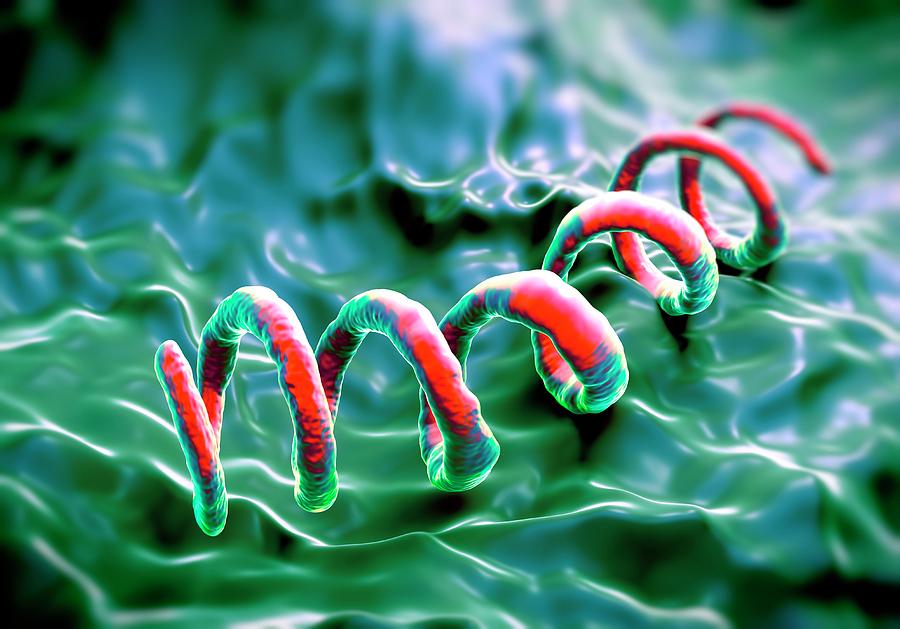
Treponema pallidum
Treponema pallidum is a spirochaete bacterium with subspecies that cause the diseases syphilis, bejel, and yaws. It is a helically coiled microorganism usually 6–15 µm long and 0.1–0.2 µm wide. The treponemes have a cytoplasmic and an outer membrane. Using light microscopy, treponemes are visible only by using dark field illumination.
Archaeabacteria (Prokaryotic)
The basis of both RNA and DNA composition and biochemistry, differs significantly from other bacteriaThought to resemble ancient bacteria that first arose in extreme environments such as sulphur-rich, deep-sea vents.Unique protein-like cell walls and cell membrane chemistry, and distinctive ribosomesInclude methane-producing bacteria, which use simple organic compounds such as methanol and acetate as food, combining them with carbon dioxide and hydrogen gas from the air, and releasing methane as a by-productBacteria of hot springs and saline areas have a variety of ways of obtaining food and energy, including the use of minerals instead of organic compounds. They include both aerobic and anaerobic bacteriaNamed because biochemical evidence indicates that they evolved before the eubacteria and have not undergone significant change since thenGenerally grow in extreme environments and have unusual lipids in their cell membranes and distinctive RNA molecules in their cytoplasm. Do not affect humans

Thaumarchaeota
All organisms of this lineage thus far identified are chemolithoautotrophic ammonia-oxidizers (capable of extracting energy and reducing power from the oxidation of ammonia to nitrite) and may play important roles in biogeochemical cycles, such as the nitrogen cycle and the carbon cycle.The phylum was proposed in 2008 based on phylogenetic data, such as the sequences of these organisms' ribosomal RNA genes, and the presence of a form of type I topoisomerase that was previously thought to be unique to the eukaryotesA study has revealed that Thaumarchaeota are most likely the dominant producers of the critical vitamin B12. Due to this vitamin, this finding has not just important implications for phytoplankton, but also atmospheric carbon dioxide, as well as DNA generation and organism development in all life which depends on the vitamin.
Eukaryotic Kingdoms

Kingdoms reference

Reproductive Structure of Fungi
(Has annotation)
Hyphae- White, fibrous structure. Can be found on roots of treesStolons - hyphae that run along surface of bread or whatever the fungus is growing onRhizoids - hyphae that penetrate into bread or whatever the fungus is onSporangiophore - hyphae that grow upward from the surface of the bread or whatever the fungus grows uponSporangia - White (young spores) or black (Older spores) spheres at the tips of sporangiophores. Filled with tiny sporesZygotes - small dark structures that are found where two hyphae meet
Chordata
- Gills present or conspicuous, appendages in 2 pairsDorsal nerve cordNotochordPaired gill slitsPost-anal tail1. Basic definition of an animal 2. Presence of radial symmetry 3. Development of bilateral symmetry4. Development of germ layers5. Presence of a false body cavity6. Modification of false body cavity to a real body cavity7. Protosome development begins8. Segmentation becomes apparent9. Jointed appendages for quicker movement10. Deuterostome development11. Development of a large dorsal nerve chord to help coordinate nervous system function 12. The development of a backbone to protect the dorsal nerve chordThe 9th most simple phyla and therefore the most complex. They feature all the listed characteristics
Urochordates
Includes tunicates. Their motile larvae display the chordate characteristics. The sessile adult retains the pharyngeal apparatus, which it uses for filter feeding. A tunicate is a marine invertebrate animal, a member of the subphylum Tunicata, which is part of the Chordata, a phylum which includes all animals with dorsal nerve cords and notochords

Stolidobranchia
Cephalochordates
They are filter feeders that burrow in the substrate of coastal waters and use their pharyngeal gill slits for filter feeding. They are small, segmented marine animals that possess elongated bodies with a notochord that extends the length of the body, extending from head to tail, persisting throughout the animal's life. Cephalochordates are represented in modern oceans by the Amphioxiformes.

Lacnelet
Vertebrate
Presence of a spinal column or backboneThe anterior part of the dorsal hollow nerve cord is enlarged into a brainThe body is normally divided into three regions: head, neck, and trunkThe presence of a tail is quite common during some point of embryonic developmentA jointed internal skeletonTwo pairs of appendages Closed circulatory system Red blood cells that contain hemoglobin Two to four chambered heartLungs and gills are the respiratory structureTwo layered skin
Agnathans
Agnatha is a superclass of jawless fish in the phylum Chordata, subphylum Vertebrata, consisting of both present and extinct species. The group is sister to all vertebrates with jaws, known as gnathostomes. notochord persists into the adult animal. Hagfishes and lampreys are vertebrates that do not have hinged jaws or bony skeletons.Lampreys and Hagfish are representative animals from this class.Lampreys cause a great deal of damage to commercial fisheries.

Lamprey
Gnathostomata
Gnathostomata are the jawed vertebrates. Gnathostome diversity comprises roughly 60,000 species, which accounts for 99% of all living vertebrates
Chondrichthyes
Chondrichthyes is a class that contains the cartilaginous fishes: they are jawed vertebrates with paired fins, paired nares, scales, a heart with its chambers in series, and skeletons made of cartilage rather than bone. The class is divided into two subclasses: Elasmobranchii and Holocephali. The fish and amphibians all require water to carry out part or all of their life cycles and lay large amounts of eggs, they do not take care of their young

Basking Shark
Osteichthyes
Osteichthyes, popularly referred to as the bony fish, is a diverse taxonomic group of fish that have skeletons primarily composed of bone tissue, as opposed to cartilage
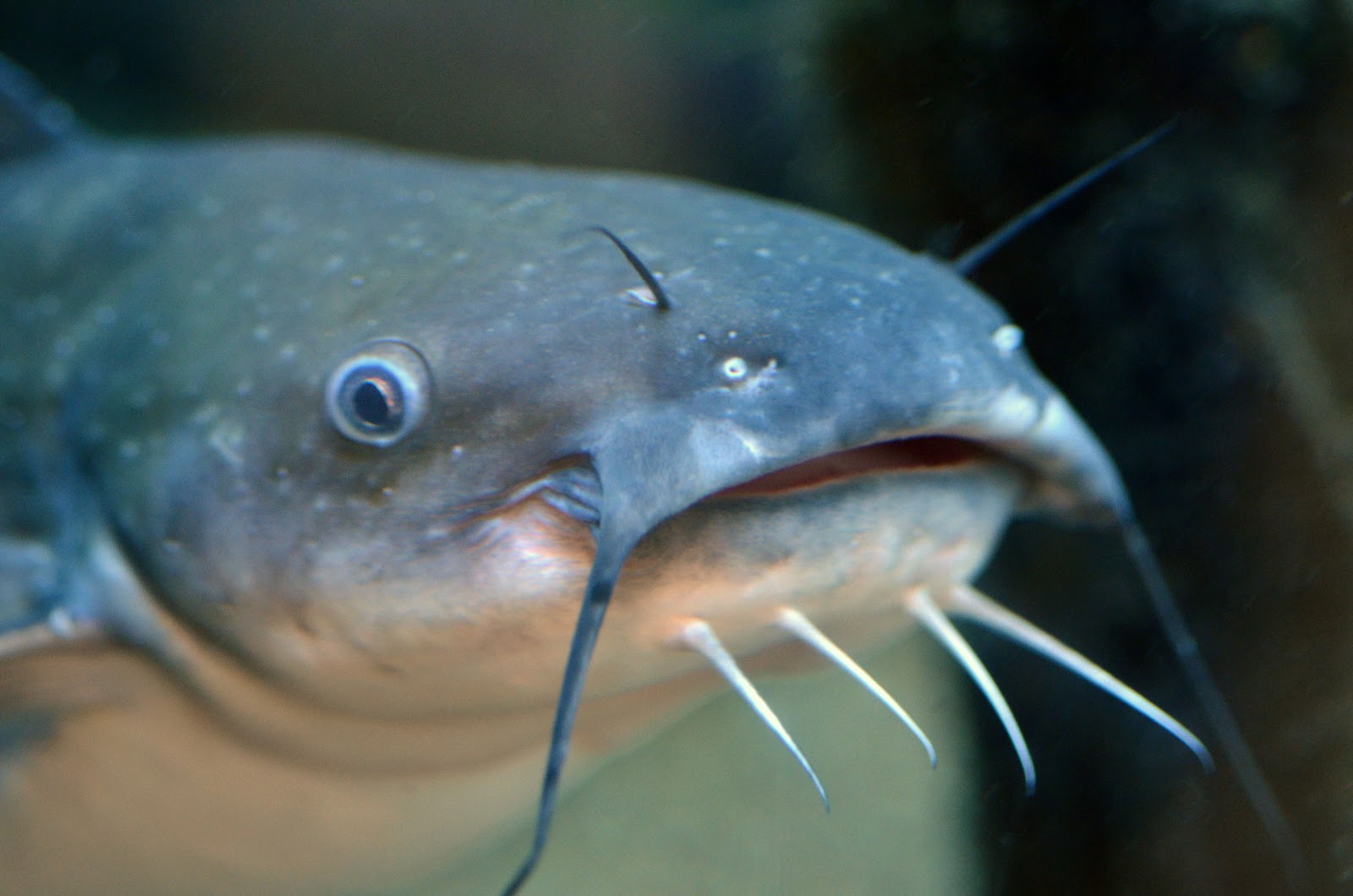
Catfish
Amphibia
Animals in this class spend part of their lives under water and part on land. Frogs, toads, and salamanders are amphibians. Many of these species must keep their skin moist by periodically returning to wet areas. All of them must return to water in order to reproduce because their eggs would dry out otherwise. They start life with gills, like fish, and later develop lungs to breathe air.

Axolotl
Reptilia
The class Reptilia includes turtles, snakes, lizards, alligators, and other large reptiles. All of them have lungs to breathe on land and skin that does not need to be kept wet. They produce an amniote egg which usually has a calcium carbonate rich, leather hard shell that protects the embryo from drying out. This is an advantage over fish and amphibians because the amniote egg can be laid on land where it is usually safer from predators than it would be in lakes, rivers, and oceansReptiliaInternal fertilizationScales3 chambered heartAmniotic egg The type of egg produced by reptiles, birds, and prototherian (egg-laying) mammals (amniotes), in which the embryo develops inside an amnion. The shell of the egg is either calcium-based or leathery.Clawed toes

Heloderma suspectum
Aves
The class Aves includes all the birds. They also produce amniote eggs but usually give them greater protection from predators by laying them high off of the ground or in other relatively inaccessible locations. In the case of both reptiles and birds, the eggs are fertilized within the reproductive tract of females. There are other striking similarities between reptiles and birds in their anatomies and reproductive systems. This is not surprising because birds are descendents of theropod dinosaurs (two-legged mostly carnivorous dinosaurs).FeathersHollow bones with air sacsGizzardEndothermicAmniotic egg4 chambered heartForelimbs are wing

Barn Owl
Mammalia
All mammals conceive their young within the reproductive tract of the mother and, after birth, nourish them with milk produced by their mammary gland Mammals are heterodonts (Variation in teeth) with strong jaws. That is to say, they have a variety of specialized teeth (incisors, canines, premolars, and molars). This allows them to chew their food into small pieces before swallowing it. Subsequently, they can eat any size plant or animal. Many reptiles must swallow their prey whole, which limits them to hunting smaller game.Presence of hair (Or modified hairs)4 chambered heartMammary glands on females (lactation)3 middle ear bonesViviparousEndothermic process which requires or absorbs energy from its surroundings, usually in the form of heat
Monotreme
Monotremes are mammals that lay eggs. Monotremes are warm blooded with a fast metabolism. They have hairy bodies and produce milk in their mammary glands.Monotremes also have other features such asProduction of milkCaring for their young in burrowsThese are advanced ('derived') features which they share with placentals and marsupialsMarsupials would be considered superior because they give live birthHave no nipples, feed milk through fur
Ornithorhynchidae

Platypuses
Marsupials
Marsupials are mammals that give birth to live young. These mammals have a pouch where their young grow and developMarsupials are hairy, warm blooded, and produce milkOne of the biggest differences between marsupials and placental mammals is that marsupials give birth quite early and rely less on the nourishment of the placentaSome examples of marsupials are kangaroo and opossumsPlacenta is an organ that develops in uterus during pregnancyEmbryonic development completed in pouch
Diprotodontia

Red kangaroo
Placental Orders
Placental mammals are mammals that give birth to fully developed live young. They differ from marsupials in that the baby spend more time being nourished by the placenta. These mammals are hairy and warm blooded as well. Some examples are mice, rats, and bats
Cetacea
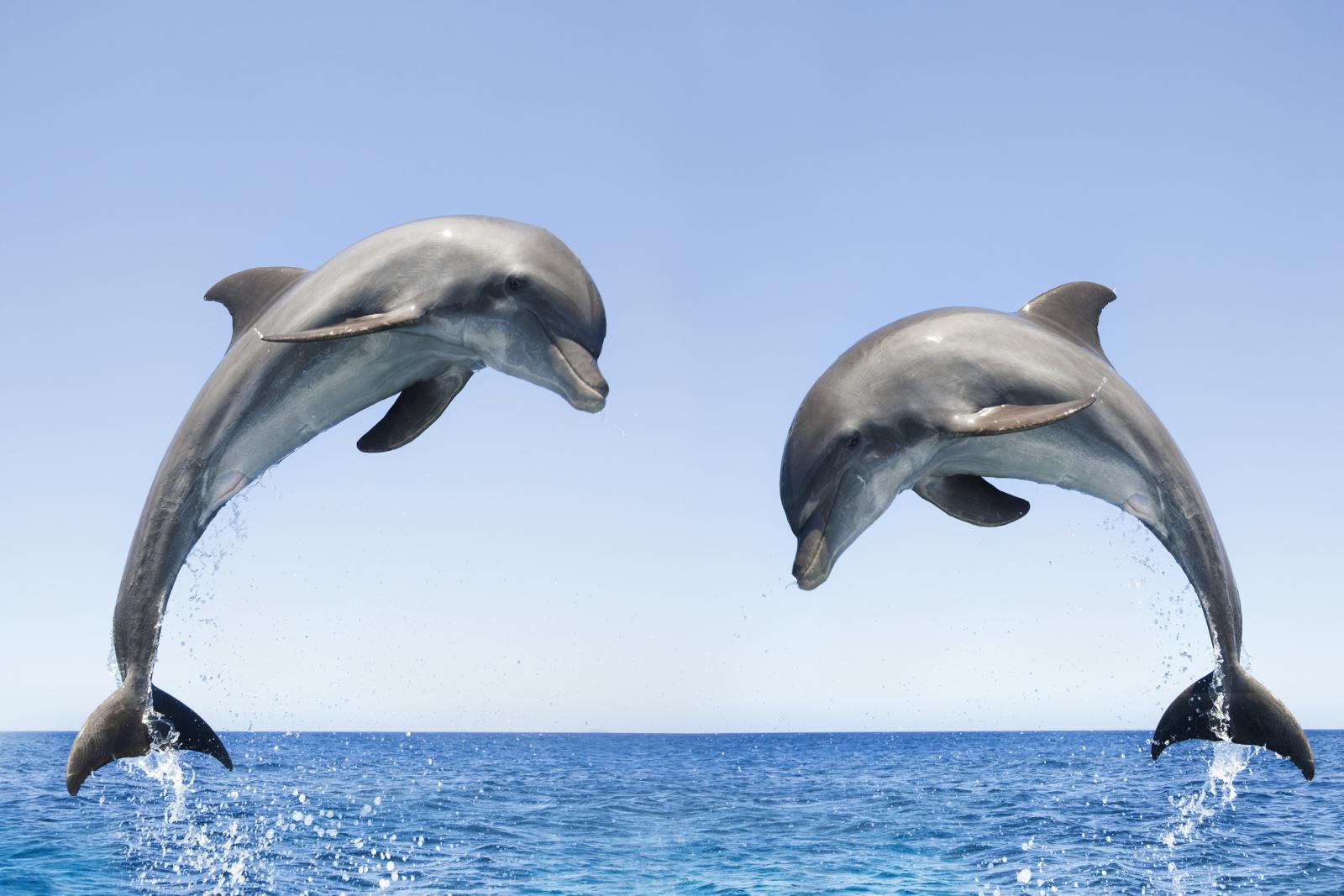
Dolphins
Echindodermata
Echinoderm is the common name given to any member of the phylum Echinodermata of marine animals. The adults are recognizable by their radial symmetry, and include such well-known animals as sea stars, sea urchins, sand dollars, and sea cucumbers, as well as the sea lilies or "stone lilies".Body that is either hard, spiny or leathery, shape is cylindrical (Usually) Exclusively marineSymmetry: Adults are radially symmetrical while the larvae are bilaterally symmetrical.Coelom: present ( coelomate)The shape of the body is flat, star like, spherical or elongated with the head being absentPresence of tube feetPresence of water vascular systemMouth is present on ventral side while anus is present on dorsal sideRespiration: by papule, gills or clocal respiratory treeCirculatory system: is reduced, heart is absentBlood has no pigment.Digestive system: completeExcretory system: absentSexes: mostly dioecious, rarely monociousReproduction: Sexual: by gamatic fusion Asexual: regenerationFertilization: externalDevelopment: indirect with characteristic larvae1. Basic definition of an animal 2. Presence of radial symmetry 3. Development of bilateral symmetry4. Development of germ layers5. Presence of a false body cavity6. Modification of false body cavity to a real body cavity7. Protosome development begins8. Segmentation becomes apparent9. Jointed appendages for quicker movement10. Deuterostome developmentThe 8th most simple Phyla, have Deuterostome development. Any member of the phyla (Chordata, Hemichordata, Echinodermata, Chaetognatha) in which the anus appears first, developing at or near the blastopore, cleavage is radial and indeterminate, and the mesoderm and coelom form from outgrowths of the primitive gut. Mouth also appears.
Asteroidea
Starfish or sea stars are star-shaped echinoderms belonging to the class Asteroidea. Common usage frequently finds these names being also applied to ophiuroids, which are correctly referred to as brittle stars or "basket stars"Generally a flattened body shapeAdult is radially symmetrical while the young is bilateralUsually 5 ( up to 40 ) armsFreely mobileTube feet for locomotionRegenerative abilities

Echinasteridae
Ophiuroidea
Brittle stars or ophiuroids are echinoderms in the class Ophiuroidea closely related to starfish. They crawl across the sea floor using their flexible arms for locomotion. The ophiuroids generally have five long, slender, whip-like arms which may reach up to 60 cm in length on the largest specimensa body plan with five part symmetry (pentaradial)An internal calcium carbonate skeleton in the mineral form of calciteAwater vascular system of fluid-filled vessels that end in tube feet
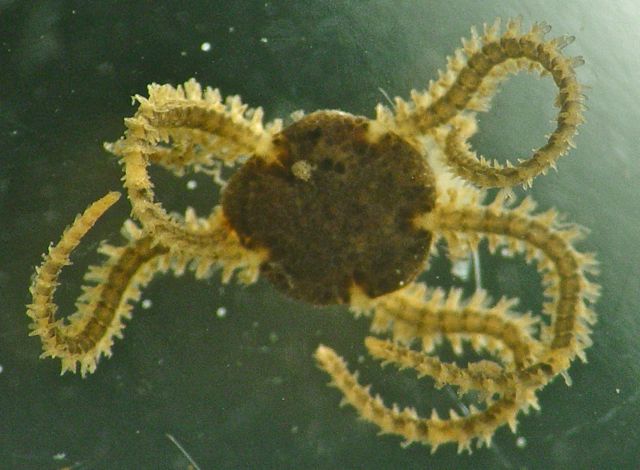
Amphiuridae
Holothuroidea
Sea cucumbers are echinoderms from the class Holothuroidea. They are marine animals with a leathery skin and an elongated body containing a single, branched gonad. Sea cucumbers are found on the sea floor worldwideLack arms.Bilaterally symmetrical.Body wall soft rather than calcareous.Dioecious with a single gonad.Sedimentary feeders.Body surrounded by tube feet.Interior madreporite.Branched tentacles surrounding mouth that are lined with modified water vascular system.

Cucumaria frondosa
Echinoidea
Sea urchins or urchins are typically spiny, globular animals, echinoderms in the class Echinoidea. About 950 species live on the seabed, inhabiting all oceans and depth zones from the intertidal to 5,000 metres. Their tests are round and spiny, typically from 3 to 10 cm acrossThey have a globoid shape without any arms are features the sea urchins share with the sea cucumbers. (The tentacles surrounding the mouth of sea cucumbers have evolved from tube feet)Like other echinoderms, they have a fivefold symmetry and move around on a large number of hydraulically powered tube feet. Sea urchins have a outer shell equipped with protecting spinesSpines are primarily used for locomotion and defense

Echinoida
Crinoidea
Crinoids are marine animals that make up the class Crinoidea of the echinoderms. The name comes from the Greek word krinon, "a lily", and eidos, "form". They live in both shallow water and in depths as great as 9,000 metersCrinoids are pentamerous, stalked echinoderms with a cuplike body bearing five usually branched and commonly featherlike arms (see figure below)Most of a crinoid's body consists of an endoskeleton composed of numerous calcareous pieces, called plates or ossicles
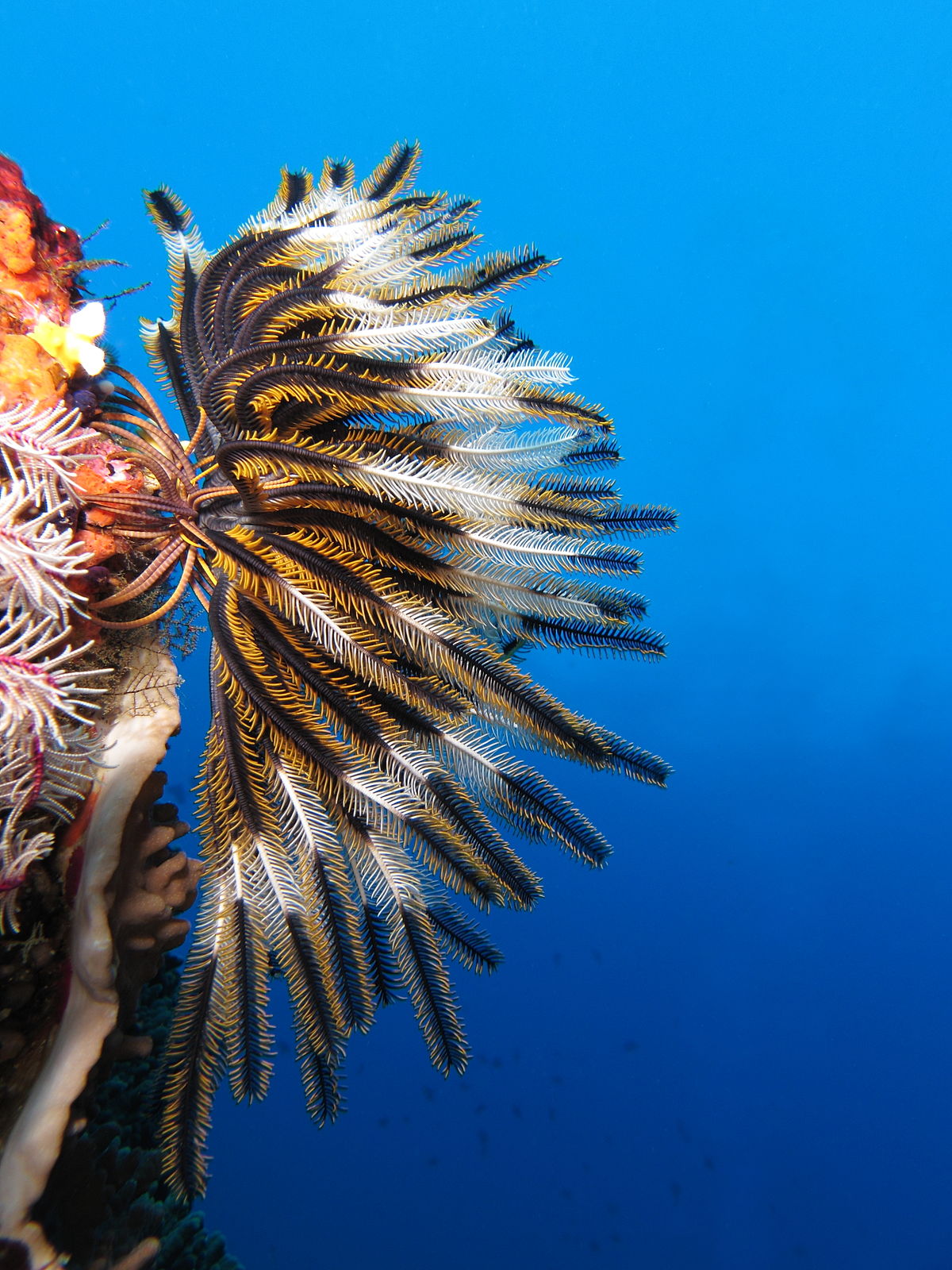
Crinoid
Mollusca
Feature Blastula Development.Body planVisceral mass with complex internal organs.Radula, a rough structure near the mouth used for scraping foodShellsMost have a protective shell or the remnants of onefootMollusks have a muscular foot, which is used for locomotion and anchorage, and varies in shape and function, depending on the type of mollusk. Foot can be modified for functions including feeding, and attachmentCoelomthe body cavity, located between the intestinal canal and the body wallMantleMantle covers the visceral mass and may secrete a shell1. Basic definition of an animal 2. Presence of radial symmetry 3. Development of bilateral symmetry4. Development of germ layers5. Presence of a false body cavity6. Modification of false body cavity to a real body cavity7. Protosome development beginsThe 5th most simple Phyla. With protosomes ( Protostomia is a clade of animals. Together with the deuterostomes and xenacoelomorpha, its members make up the Bilateria, mostly comprising animals with bilateral symmetry and three germ layers.) A multicellular organism whose mouth develops from a primary embryonic opening, such as an annelid, mollusk, or arthropod
Gastropods
The gastropods, more commonly known as snails and slugs, belong to a large taxonomic class of invertebrates within the phylum Mollusca, called Gastropoda. This class includes snails and slugs of all species and sizes, from microscopic to Achatina achatina, the largest known land gastropodInclude snails and slugsFound in marine, fresh-water, and terrestrial habitats.Have a radula, which many species use to scrape vegetation. Others are carnivorous and use the radula to drill into the shells of other mollusks

Chromodoris
Cephalopod
A cephalopod is any member of the molluscan class Cephalopoda such as a squid, octopus or nautilus. These exclusively marine animals are characterized by bilateral body symmetry, a prominent head, and a set of arms or tentacles modified from the primitive molluscan footCephalopods are fast moving, intelligent predators with excellent visionThe foot is modified into tentacles and they can move by jet propulsion when they expel water from their mantle cavitiesThis is the only group of mollusks with a closed circulatory system

Teuthida (Squid)
Squid are cephalopods of the two orders Myopsida and Oegopsida, which were formerly regarded as two suborders of the order Teuthida, however recent research shows Teuthida to be paraphyletic. The two current orders comprise around 304 species
Bivalves
Bivalvia, in previous centuries referred to as the Lamellibranchiata and Pelecypoda, is a class of marine and freshwater molluscs that have laterally compressed bodies enclosed by a shell consisting of two hinged partsClams, oysters, and scallopsAll have a two- part shell held together by powerful muscles.They have no head and may use their powerful foot to burrow into the substrateThey filter food from water passing over the gills and sweep it to the mouth

Pectinidae (Scallop)
Annelida
The annelids, also known as the ringed worms or segmented worms, are a large phylum, with over 22,000 extant species including ragworms, earthworms, and leeches. Conspicuous segments Digestive tractBody segmentationCoeloma (body cavity completely within the mesoderm aka a true/real body cavity)Closed circulatory systemAnnelids are all bilaterally symmetrical animalsBody wallParapodia (Paired, un-jointed lateral outgrowths that bear the chaetae) Segmental organs.1. Basic definition of an animal 2. Presence of radial symmetry 3. Development of bilateral symmetry4. Development of germ layers5. Presence of a false body cavity6. Modification of false body cavity to a real body cavity7. Protosome development begins8. Segmentation becomes apparent The 6th most simple phyla. Features segmentation
Oligochaeta
Oligochaeta is a subclass of animals in the phylum Annelida, which is made up of many types of aquatic and terrestrial worms, including all of the various earthworms.Oligochaete worms have long, segmented, tubular bodiesGet around by peristalsis (series of wave-like muscle contractions that moves)Simultaneous hermaphroditesHave a brain and nervous system, with a central nerve cord running the entire length of the worm's body
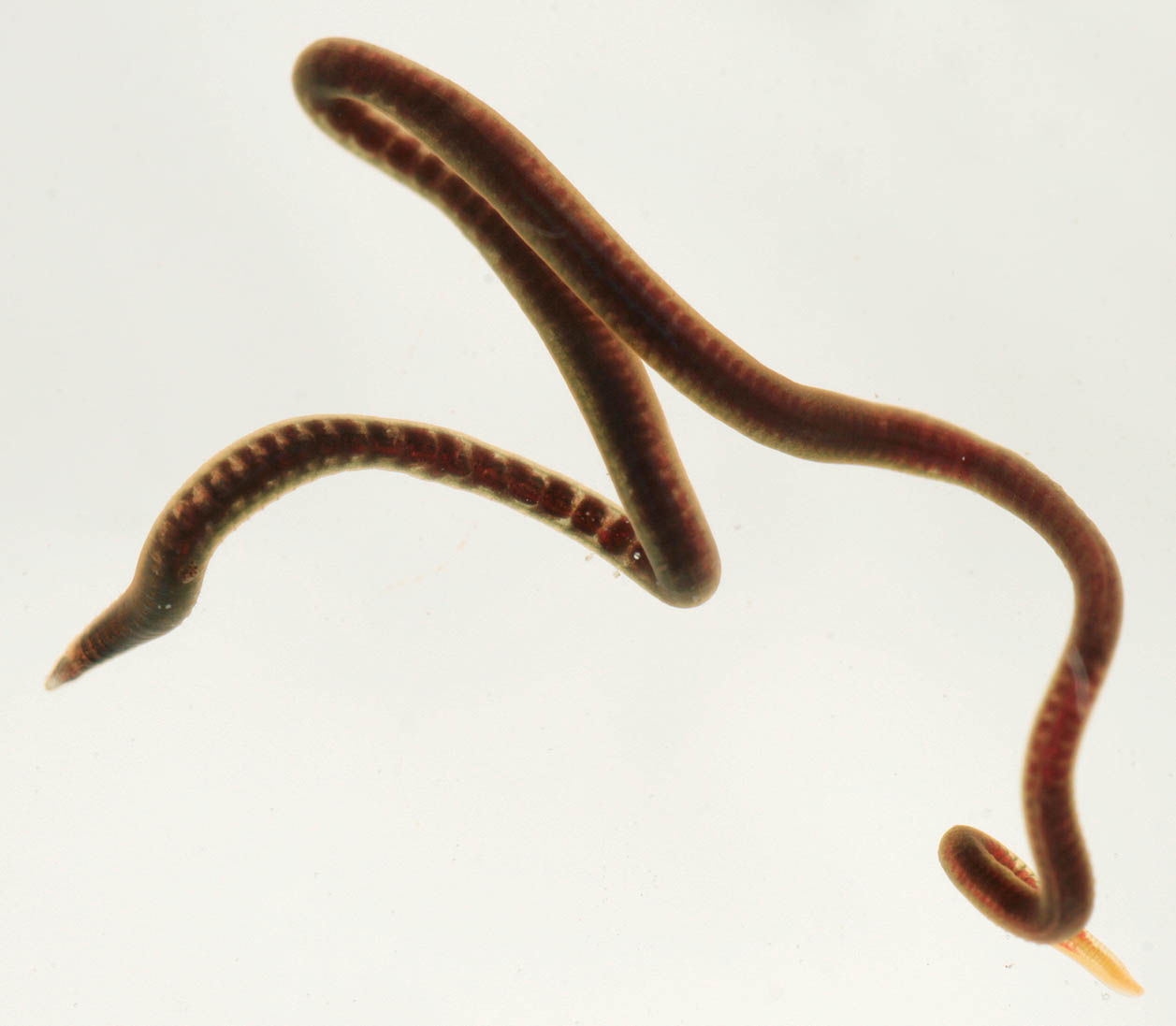
Lumbriculidaev
Polychaeta
The Polychaeta, also known as the bristle worms or polychætes, are a paraphyletic class of annelid worms, generally marine. Each body segment has a pair of fleshy protrusions called parapodia that bear many bristles, called chaetae, which are made of chitinMarine annelids with parapodia bearing numerous setae in distinct fascicles.They are dioecious and multi-segmented.They have simple exit ducts from the gonads.Most of them live in soft or rocky environment on sea floor from intertidal to depth. They may be, but rarely, found in freshwater and terrestrial (humid), or parasitic.The sex of most polychaetes are separate. The gametes produced in a few specialized segments are shed into the coelom and leave the body through the nephridiaAfter the external fertilization, a ciliated free-swimming trochophore larval is developedBisymmetry, metamerism, segmentation, schizocel, closed vascular system, chain nervous system, spiral and determinant cleavage

Nereis
Hirudinea (Leech)
Leeches are segmented parasitic or predatory worm-like animals that belong to the phylum Annelida and comprise the subclass Hirudinea. They are closely related to the oligochaetes, which include the earthworms, and like them have soft, muscular, segmented bodies that can lengthen and contractThe majority of worms in this class are freshwater, but some are terrestrial and a few live in marine watersPiscicola geometra feeds exclusively on the blood of fishes. It occurs widely throughout the Northern Hemisphere Glossiphonia complanata, which feeds on the fluids in snails, is common in North America and occurs on the Canadian Arctic mainland where its hosts liveThis species carries its eggs on its body to care for them until they hatch. Not all leeches suck blood – about one quarter of species are predators of other worms, snails, and insects. They have two suckers: one at the front end and one at the hind endThey also possess four muscle layers in comparison to the two layers of other annelidsAnother difference is that leeches lack the hairs that are present on the bodies of other worms to anchor themselvesAs a consequence of these structural differences, leeches crawl and swim, but are unable to burrow. In order to crawl, a leech uses its two suckers to alternately anchor itself to the substrateAll leeches are hermaphroditic, with every individual having both male and female reproductive partsThey cannot self-fertilize, however, but must mate because their eggs and their sperm develop at different timesUnlike other annelids, leeches cannot reproduce asexually or regenerate damaged body segmentsAfter copulation, eggs are laid in a cocoon, which contains a nutritious protein called albumin – the same protein that is found in egg whitesMost leech species release the cocoon into the environment, or attach it to the substrate, vegetation, or the host

Hirudo medicinalis
Hirudo medicinalis, the European medicinal leech, is one of several species of leeches used as "medicinal leeches". Other species of Hirudo sometimes also used as medicinal leeches include H. orientalis, H. troctina, and H. verbana
Platyhelminthes
The flatworms, flat worms, Platyhelminthes, Plathelminthes, or platyhelminths are a phylum of relatively simple bilaterian, unsegmented, soft-bodied invertebrates. They have 3 main tissue types (ecto, meso, endo). - Body without jointed appendages, soft, flattened and worm like Bilaterally symmetrical with a head and a tailCentralized nervous systemthree tissue layersno Coelom (body cavity), acoelomate (an invertebrate lacking a coelom especially) no particularity system and no hard skeleton1. Base definition for an animal2. Presence of Radial symmetry3. Development of Bilateral symmetry4. Development of germ layers5. Presence of a false body cavityAre the 3rd most simple Phyla. they feature the above characteristics. They have a false body cavity which is a notable feature
Turbellaria
Turbellarians share some important characteristics with other Platyhelminthes. All flatworms are flattened dorsoventrally . They are bilaterally symmetrical , are unsegmented, and are acoelomates , which means they do not have a body cavity. Planarians (Type of Turbellarian) are active predators and scavengers, gliding along surfaces searching for prey. They are mostly aquatic. Turbellarians move around using cilia on their epidermis or by undulating their body with their muscles Most turbellarians live in water, either fresh or salt waterTurbellarians reproduce by fission and regeneration, or sexuallyTurbellarians that reproduce sexually are hermaphroditic—sperm from one animal will fertilize eggs from another, and the eggs then hatch into small turbellariansWhen reproducing by fission and regeneration, the tail end of the individual turbellarian adheres to a substrate and the head region pulls away from the tail This eventually splits the flatworm in two, and each piece regenerates the end that is missing. Turbellarians are the only flatworms that can reproduce by fission

Pseudoceros Dimidiatus
Pseudoceros dimidiatus, the divided flatworm or tiger flatworm, is a species of flatworm in the genus Pseudoceros, belonging to the family Pseudocerotidae
Trematoda
Trematoda is a class within the phylum Platyhelminthes. It includes two groups of parasitic flatworms, known as flukes. They are internal parasites of molluscs and vertebrates. Most trematodes have a complex life cycle with at least two hosts. The primary host, where the flukes sexually reproduce, is a vertebrateFall into two main subclasses, Monogena (Direct life cycle) and Digenea (Require intermediate host)The adult Digenetic trematodes (Flukes) occour primarliy in bile ducts, alimentary tract and the vasuclar systemMost flukes are flattened dorosverntrally, have a blind alimetary tract and suckers for attachementThe tapeworms and the flukes are very specialized parasites with complex hostparasite life cycles. Humans are sometimes host to some species of parasitic flatworm
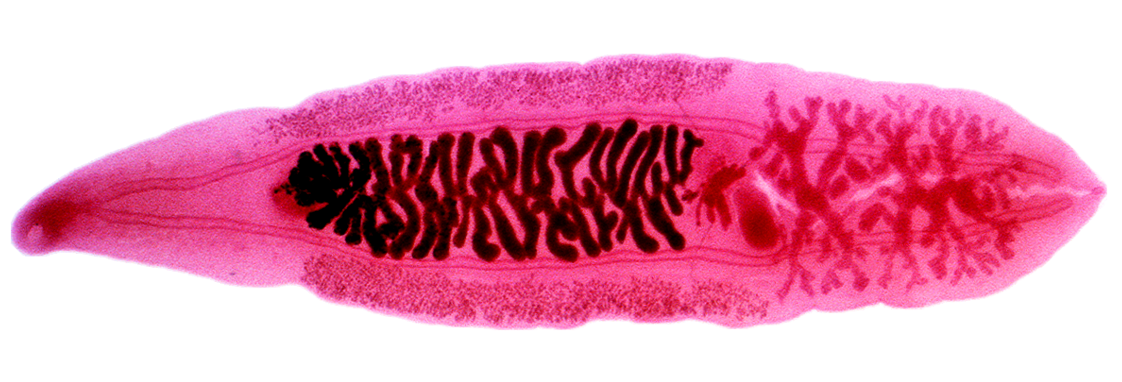
Clonorchis sinensis
Clonorchis sinensis, the Chinese liver fluke, is a human liver fluke belonging to the class Trematoda, phylum Platyhelminthes. This parasite lives in the liver of humans, and is found mainly in the common bile duct and gall bladder, feeding on bile
Monogenea
Monogeneans are a group of ectoparasites commonly found on the skin, gills, or fins of fish. They have a direct lifecycle and do not require an intermediate host. Adults are hermaphrodites, meaning they have both male and female reproductive structures.Marine & freshwater parasites Most are external parasites on fish and other sea creaturesSome are found in urinary bladder, have a direct life cycle

Monogenetic trematodes
Cestoda
Cestoda is a class of parasitic worms in the flatworm phylum. Most of the species—and the best-known—are those in the subclass Eucestoda; they are ribbonlike worms as adults, known as tapeworms.Long, segmented and tape likeDorso ventrally flattened Size varies Adult worms are found in the human intestinesThere are 3 regions (Head is scolex, Neck, the body which is Strobila and features segements called progottids).

Hydatigena taeniaeformis
Nematoda
The nematodes or roundworms constitute the phylum Nematoda. They are a diverse animal phylum inhabiting a broad range of environments. 4 classes, Chromadorea, Enoplea, Secernentea and Dorylaimea. Smooth slender body without obvious segments Bilateral symmetryComplete digestive tractBody cavity (Pseudocoelomate)1. Basic definition of an animal 2. Presence of radial symmetry 3. Development of bilateral symmetry4. Development of germ layers5. Presence of a false body cavity6. Modification of false body cavity to a real body cavityThe 4th most simple phyla. The most distinctive new feature is the pseudocoelomate.
Chromadorea
The Chromadorea are a class of the roundworm phylum, Nematoda. They contain a single subclass and several orders. With such a redundant arrangement, the Chromadoria are liable to be split up if the orders are found to form several clades, or abandoned if they are found to constitute a single radiation.Pore-like or slit-like amphid apertures vary from labial pores or slits to post-labial elaborate coils and spirals.Cuticle usually annulated, sometimes ornamented with projections and setae.Phasmids present or absent, generally posterior.Esophagus usually divided into bulbs, with 3 to 5 esophageal glands. Excretory system glandular or tubular.Female with one or two ovaries.Caudal alae present or absent.
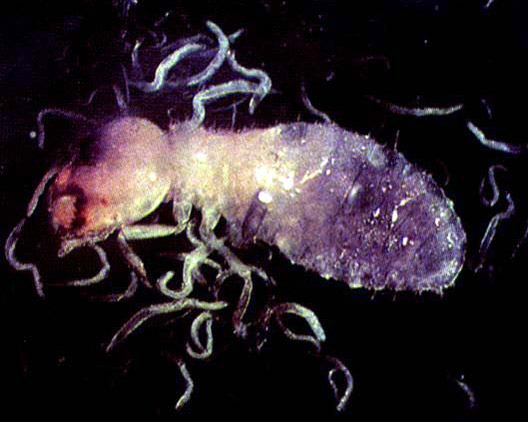
Steinernema
Cnidaria
Soft body with single body opening (Usually has tentacles around it) has radial symmetry with a shell shaped structure with many small pockets two body form typesJelly fish like and Sea anemone like, looks like one is flipped overStationary polyp (anemone)Free swimming medusa (jellyfish)gastrovascular cavityPrimary organ of digestion and circulation in two major animal phyla: the Cnidaria (including jellyfish and corals) and Platyhelminthes (flatworms). The cavity may be extensively branched into a system of canals.radial symmetrySymmetry around a central axis, as in a starfish or a tulip flower.NematocystsNematocyst, minute, elongated, or spherical capsule produced exclusively by members of the phylum Cnidaria (e.g., jellyfish, corals, sea anemones). Several such capsules occur on the body surface. Used to sting and inject with using barb like structures.2 tissue layersThe outer ectoderm, or epidermis, contains the cnidocysts, the stinging cells that are characteristic of the phylum.The inner endoderm, or gastrodermis, lines the gut, which in some cnidarians may be divided up by septa (as in the Anthozoa) or elaborated into branching canals1. Base definition for an animal2. Presence of Radial symmetry2nd most basic phyla, have radial symmetry
Hydrozoa
Hydrozoa are a taxonomic class of individually very small, predatory animals, some solitary and some colonial, most living in salt waterInternal space for digestion is the gastrovascular cavityGastrovascular cavity has one opening, the mouthExoskeleton of chitinAre almoust entirely marine and predatorsSexual reproduction produces the planula larvaeTwo body forms, a polyp and meduseaPresence of stinging cells called CnidocytesSome Hydrozoans live on the the surface floating with large sail like structures above water for locomotion and long tentacles with nematocytes or stinging cells below the surface to catch food. A second group live in the middle water zone or pelagic region. These organisms such as the Chelia and Bougainvillae umbrella shaped with long tentacles emerging from the ventral region and move by jet propelling themselves up and passively sinking down. The third region for the Hydrozoans is the bottom where they anchor themselves to the substrate. These Hydrozoans are the orders Milleporina and Stylasterina which are corals and form an internal, epidermal skeleton of calcareous. These organisms can grow very large covering mass amounts of ocean substrate. Another sessile Hydrozoa is the Hydra which is truely unique among the Hydrozoans. The Hydra is solitary, lacks a medusoid phase and feeds with long tentacles that extend from around the mouth.

Aequorea victoria
Scyphozoa
The Scyphozoa are an exclusively marine class of the phylum Cnidaria, referred to as the true jellyfishMedusa form dominates the life cycle, and some do not have a polyp stage The medusae may be large, are often colored (often red, orange, or yellow), do not have a velum The margins of the bell are usually lobed into lappets and do not usually have a ring canalSense organs are usually found in the notches between lappetsThe mouth is not usually on an extended manubriumThe gut is divided into 4 branches by mesenteriesCnidae are present in both the epidermis and the gastrodermis Polyps, if present, are small and inconspicuous. The polyps produce medusae by asexual budding (strobilization).

Chrysaora hysoscella
Anthozoa
Anthozoa is a class of marine invertebrates which includes the sea anemones, stony corals, soft corals and gorgonians. Adult anthozoans are almost all attached to the seabed, while their larvae can disperse as part of the planktonTropical marine habitatMouth surrounded by tentacles with nematocysts.Partioned gastrovascular cavitySecretes nonliving substance around outside of body to support and protect soft body tissuesReproduces sexually by producing a free-swimming larva (planula) or asexually by budding or fissionCylindrical, with radial symmetry

Antipatharia
Also known as Black Coral
Cubozoa
Look like basic jellyfish, but can swim pretty fast, maneuver around things, and see fairly well despite not having a brainIn general, box jellies are similar in form to the "true" jellyfish, known as scyphozoans. However, it is relatively easy to tell the two groups apart. Cubozoans have a square shape when viewed from above. (Gee, maybe that's how they got their name.) They also have four evenly spaced out tentacles or bunches of tentacles and well-developed eyesNot surprisingly, given their squishy nature, there are not many fossil cubozoans knownToday, there are about 20 known species found in tropical and semitropical waters The Australian stinger Chironex fleckeri is among the deadliest creatures in the world, having caused human fatalities

Chironex fleckeri
Porifera
Sponges, the members of the phylum Porifera, are a basal Metazoa clade as a sister of the Diploblasts. They are multicellular organisms that have bodies full of pores and channels allowing water to circulate through them, consisting of jelly-like mesohyl sandwiched between two thin layers of cells. Body form is more or less irregular with little obvious structure (no appendages or obvious sensory organs). Soft and has many pores. Characteristics includeAsymmetricalOrganized as an assemblage of different kinds of specialized cellsLack tissuesHave a skeleton lacking or made of spiculeReproduce sexually or asexually1. Base definition for an animalDoes not feature symmetry as they are asymmetrical.They would the most basic phyla

Demospongiae
Demospongiae is the most diverse class in the phylum Porifera. They include 76.2% of all species of sponges with nearly 8,800 species worldwide. They are predominantly leuconoid in structure. Their "skeletons" are made of spicules consisting of fibers of the protein spongin, the mineral silica, or both
Arthropods
Jointed appendages with external skeleton, no gill slits and appendages in many pairs, has symmetry Some Characteristics (Not all have them)Hard exoskeleton made of chitin and proteinPossess numerous jointed appendages and a segmented bodyMust molt to growJointed appendagesSegmentationDistinct head, often with compound eyesExoskeletonRespiration by gills, tracheae, or book lungsOpen circulatory systemExcretion through Malpighian tubulesWings on many arthropods1. Basic definition of an animal 2. Presence of radial symmetry 3. Development of bilateral symmetry4. Development of germ layers5. Presence of a false body cavity6. Modification of false body cavity to a real body cavity7. Protosome development begins8. Segmentation becomes apparent9. Jointed appendages for quicker movementThe 7th most simple phyla, feature jointed appendages, they are protosomes as they are an animal whose mouth is formed from the blastopore during embryonic development.
Domains
Test
Class
Test
Phyla
Test
Subphylum
Test
Super Class
Test
Order
Test
Family
Test
Plants
Characteristics multi-cellularPhotosynthetic– Contain chlorophyll a and bAlternation of Generations–An alternation between A diploid and haploid generationdevelop from embryos– arise from multi-cellular structures in the maternaltissue– product of sexual fusion thereby indicating that allplants (even though this is not actually true) have asexual stage at some point in their life cycle
Bryophytes
mosses, liverworts, and hornwortsthree phyla are traditionally called bryophytesThe gametophyte is the dominant portion of the life cycleplants appear leafy but lack true stems, roots or leavesthey lack vascular tissue they are all limited in size, most are no larger than 20 cm tallgenerally found in moist habitatssmall plantsno true stems or leavesrhizoids only (Roots)dominant plant is haploid / is the gametophytespores produced in a capsulenon-vascular / lack of xylem and phloemDispersalNeed water to reproduceGet nutrients through air
Bryophyta(Moss)

Polytrichum commune
Anthocerophyta (Hornworts)

Phaeoceros laevis
Hepaticophyta (Liverworts)

Stephensoniella brevipedunculata
Seedless Vascular
Whisk ferns, the club mosses (lycopods), the horsetails and the FernsVascular tissueMoist habitats-motile sperm swimming to an eggHave leaves called frondsSporophyte (diploid multicellular stage in the life cycle of a plant) is the dominant part of the life cyclesStomata, a protected embryo, and most have a waxy cuticleAlso known as filicinophytesseedlessvascular tissues / xylem and phloemrootsleaves and stemsspores produced in clusters / spores usually produced under the leavesprothallus / small gametophyte / gametophyte grows independently
Ptetrophyta (Ferns)

Ostrich Fern
Lycophyta (Club Mosses)

Sphagnum flexuosum
Psilotum (Whisk Fern)

Psilotum nudum
Lycopodiophyta

Lycopodiella inundata
Gymnosperms
naked seeds.seed is not covered with a fleshy fruit.sporophyte produces both male and female conesfour phylaconifers, cycads, the ginkgo, and gnetophytesSeed Plantsgametophyte is much reduced The gametophytes are not free-living–retained within the reproductive tissues of the sporophyte Pollination replaces the sperm cell swimming to the egg–Drought-resistant pollen is carried to the female tissues by wind or animalsThe zygote is protected in a seed–The seed can be dispersed, unlike the zygote of non-seed plants
Coniferophyta (Conifers)

Pinus strobus
Cycadophyta (Cycads)

Zamiaceae
Ginkgophyta (Ginkgo)
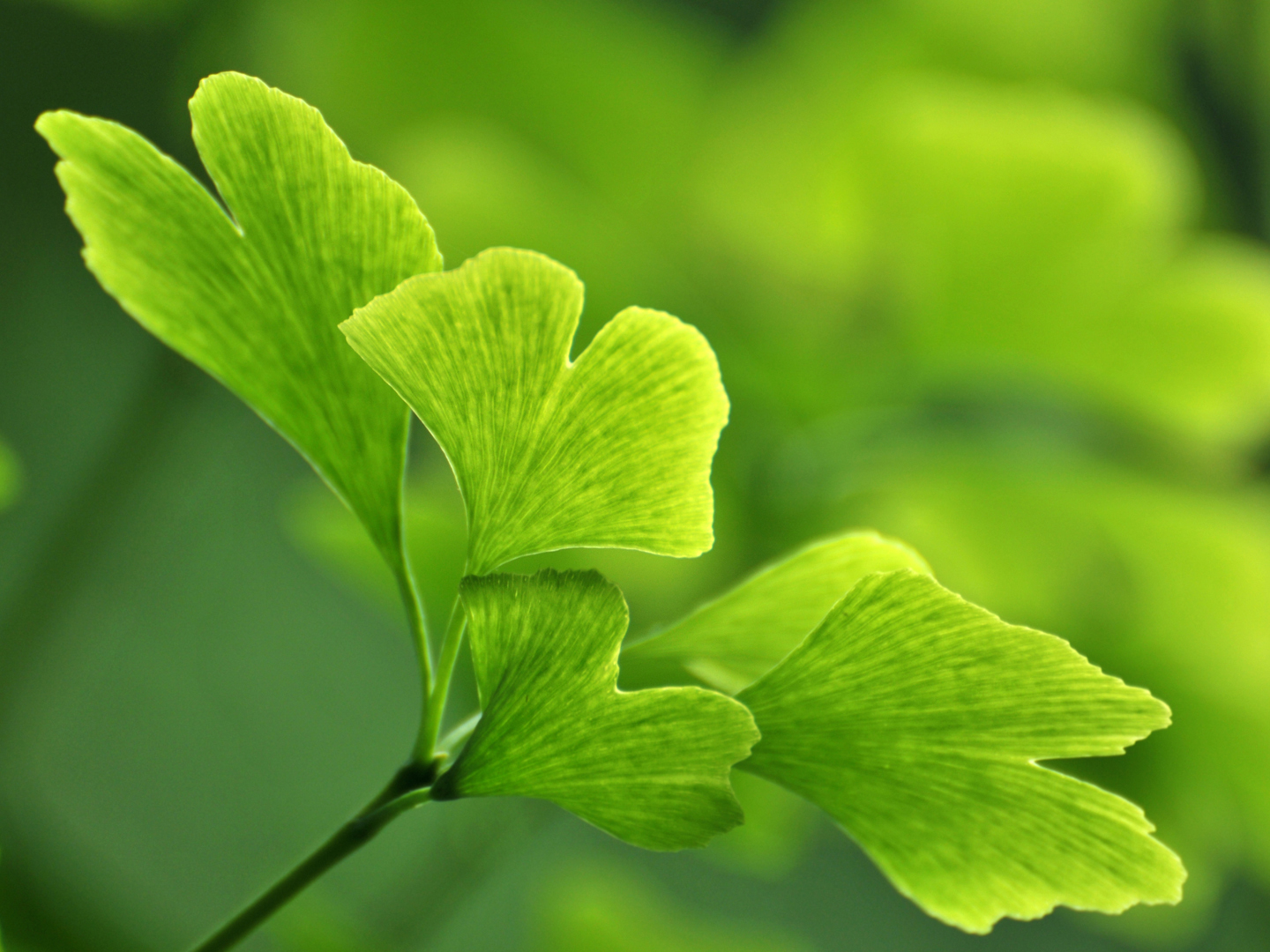
Ginkgo biloba
Gnetophyta (Gnetophytes)

Gnetum gnemon
Angiosperms
Flowering plants-Anthophyta-reproduction takes place within the flower-sporophyte is the dominant part of the life cycle.-PollinationDispersal-They need a method to disperse their gametes and seedsSecondary Metabolites-Chemicals that are necessary for life OR allow the plant to be successfulThe gametophytes are microscopicAngiosperms (representing the epitome of plant evolution) aredivided into two major groupsAlso known as angiospermophytesflowers / flowering plantsovules / seed are enclosedfruitsxylem vessels
Anthophyta (Flowering Plants)
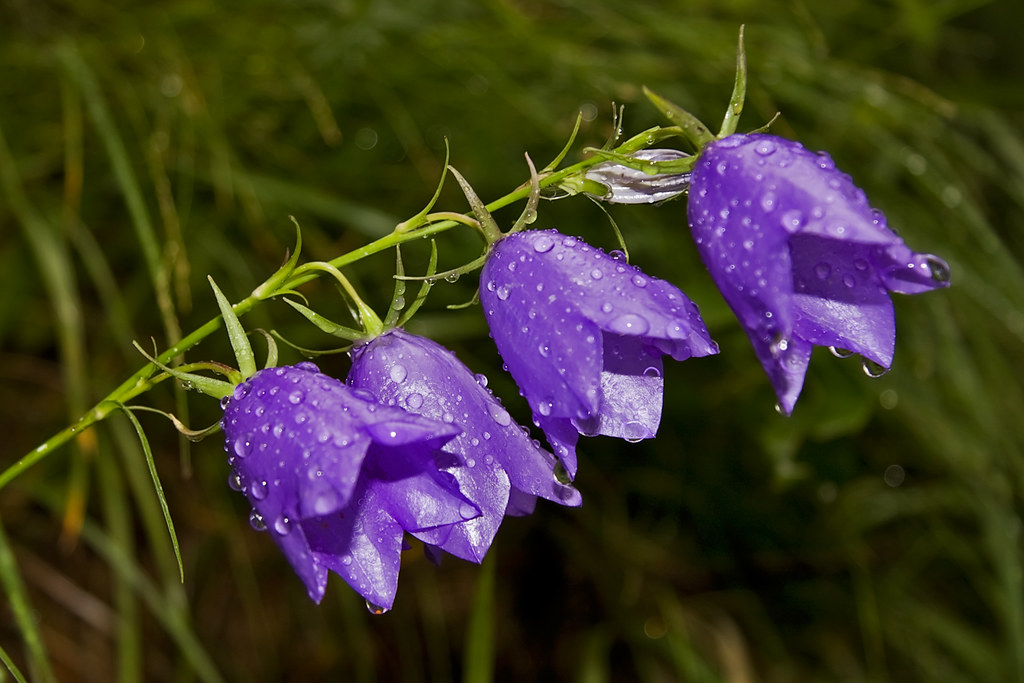
Bellflowers
Adaptations Chart
Protista
Kingdom of simple eukaryotic organisms, usually composed of a single cell or a colony of similar cells. Protists live in water, in moist terrestrial habitats, and as parasites and other symbionts in the bodies of multi-cellular eukaroytes.Other eukaryotic kingdoms are each believed to be monophyletic. As in, all plants evolved from one ancestral plant, all animals from one ancestral animal, and all fungi from one ancestral fungus. The Protista, however, are not; they are almost certainly polyphyletic and did not arise from a single ancestral protist.The Protista are a category of miscellaneous eukaryotes, not closely related to each other and not sharing many characteristics, but not fitting any other kingdom of life.Catch all kingdomOrganisms that don't fit into the definition of the other kingdoms, they are so diverse in structure that they can be divided into multiple kingdomsCharacteristicsAll protists are aquaticsome are marine, some freshwater, some live in moist terrestrial environments, some are parasitic or some exist in moist tissueThey can be heterotrophic or autotrophic, they are motile (They move), they are unicellular (Some are multi-cellular), they are large complex cells with many organelles, and they reproduce asexually or sexuallyProtists move in one of 3 waysPseudopod: A temporary projection of the cytoplasm of certain cells, such as phagocytes, or of certain unicellular organisms, such as amoebas, that serves in moving from one place to another. Typically amoebas move this wayCilia: an organelle found in eukaryotic cells. Cilia are slender protuberances that project from the much larger cell body. There are two types of cilia: motile cilia, which beat against fluid outside the cell. non-motile, or primary cilia, which typically serve as sensory organelles. They are like tiny hairs on a cellFlagellum : a slender threadlike structure, especially a microscopic whiplike appendage that enables many protozoa, bacteria, spermatozoa, etc., to swim. An example would be the Sperm cell
Grouping System
Classification:a protist is any eukaryote that is not an animal, (land) plant, or (true) fungus; this definition excludes many unicellular groups, like the Microsporidia (fungi), many Chytridiomycetes (fungi), and yeasts (fungi)Taxonomy:- Can be based on eukaryotic microorganisms and their immediate descendants- often classified based on their behaviour often classified based on their behaviour into eitherplant-like, animal-like and fungus-like protistsCan also be classified or grouped based on their method of moving. Protists move in one of 3 waysPseudopod: A temporary projection of the cytoplasm of certain cells, such as phagocytes, or of certain unicellular organisms, such as amoebas, that serves in moving from one place to another. Typically amoebas move this wayCilia: an organelle found in eukaryotic cells. Cilia are slender protuberances that project from the much larger cell body. There are two types of cilia: motile cilia, which beat against fluid outside the cell. non-motile, or primary cilia, which typically serve as sensory organelles. They are like tiny hairs on a cellFlagellum : a slender threadlike structure, especially a microscopic whiplike appendage that enables many protozoa, bacteria, spermatozoa, etc., to swim. An example would be the Sperm cell
Animal Like
Animal-like protists are called protozoaProtozoa are single-celled eukaryotes that share some traits with animalsLike animals, they can move, and they are heterotrophs. That means they eat things outside of themselves instead of producing their own food.Animal-like protists include the flagellates, ciliates, and the sporozoans.All are unicellularCategorized by how they move:– With Pseudopods– With Cilia (ciliates)– With Flagella (zooflagellates)– Others (Parasites)
Sarcodines
Sarcodina, the largest phylum of protozoans. It comprises the amoebas and related organisms; which are all solitary cells that move and capture food by means of pseudopods, flowing temporary extensions of the cell. Most sarcodines are free living; others are parasitic.Reproduce asexually or sexually via binary fissionLive in fresh and salt waterCharacterized by pseudopodsPseudopod = “fake foot”Move by extending their pseudopods and pulling the rest of their bodies forwardPseudopods also used to trap food

Ameoba proteus
Characterized by Pseudopods which stands forfalse feet. These false feet normally stretchtowards the preyInfo: Rely on ability to engulf and surround prey. Are slow and prey on slow moving preyVisual of hunting: https://upload.wikimedia.org/wikipedia/commons/4/4e/Phagocytosis_--_amoeba.jpg
Ciliates
The ciliates are a group of protozoans characterized by the presence of hair-like organelles called cilia, which are identical in structure to eukaryotic flagella, but are in general shorter and present in much larger numbers, with a different undulating pattern than flagellaCillia allow it to move through whatever it is in, these are tiny hairs and move in unison to help propel and move the protistReproduce sexually via conjugation and asexual by binary fissionLive in fresh and salt waterCharacterized by CiliaTiny hair-like structuresMove by beating tiny cilia that act like oars Cilia also help capture food

Paramecium caudatum
A species of unicellular organisms belonging to the genus Paramecium of the phylum Ciliophora. They can reach 0.25mm in length and are covered with minute hair-like organelles called cilia. The cilia are used in locomotion and feeding.Reproduction: sexual by conjugation and asexual by binary fission Cilia are also used to propel and direct food toward the mouth opening. Many protists have a contractile vacuole that helps to get rid of excess water in the cell. Ciliates also feature a rigid outer shape
Zooflagellates/Zoomastigina
Zoo-flagellates are non-photosynthetic flagellates without plastids or cell walls which feed by phagocytosis or endocytosis. They are the most diverse of all eukaryotes and gave rise directly or indirectly to most, if not all, other groups of eukaryotes.Live in water or within another organismReproduce sexually & asexuallyCharacterized by flagella which it whips to move Flagella - whip-like tail Move by beating their long flagella Can have one or more flagella Most flagellates live in a host; can be helpful or harmful Termites dependence on a certain species of Zoo-flagellate: Termites live on cellulose, mostly from the dead wood they chew, but they depend on protozoa in their gut to provide the enzymes that can digest the wood," Poinar said."These protozoa would die outside of the termite, and the termite would starve if it didn't have the protozoa to aid in digestionImportance of trypanosoma gambiense: species of parasitic kinetoplastid belonging to the genus Trypanosoma. The parasite is the cause of a vector-borne disease of vertebrate animals, including humans, carried by genera of tsetse fly in sub-Saharan Africa. In humans T. brucei causes African trypanosomiasis, or sleeping sickness
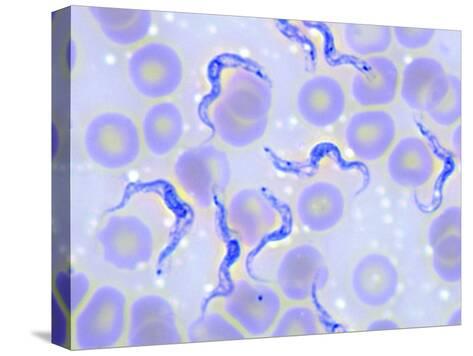
Trypanosoma gambiense
A species of parasitic kinetoplastid belonging to the genus Trypanosoma. The parasite is the cause of a vector-borne disease of vertebrate animals, including humans, carried by genera of tsetse fly in sub-Saharan Africa. In humans it causes African trypanosomiasis, or sleeping sickness.
Sporozoans
The sporozoans are able to form spore-like cells, from which they get their name. Parasitic & produce spores during asexual reproduction. Spores allow it to spread and the life cycle is usually complex and involves multiple hosts Sporozoans do not have flagella, cilia, or pseudopodia. They are capable of gliding movementsAll sporozoans are parasites of animals and cause disease.They are also characterized by the presence of a unique cellular structure called an apical complexThe apical complex secretes enzymes which allow the sporozoan to enter a host cellReproduce SexuallyLive in the gut of insects or vectors. Plasmodium lives and reproduces in the stomach of the female MosquitoThey are Non-Motile

Plasmodium
Plasmodium is a genus of unicellular eukaryotes that are obligate parasites of vertebrates and insects. They feast off a host.
Plant Like
Plant-like protists, also called algae are a large and diverse group of simple plant-like organisms. They are autotrophs Some algae are tiny and unicellular, others are large and multicellularThe largest and most complex marine forms are called seaweedsThey are considered "plant-like" because they photosynthesize, and are considered "simple" because they do not have the distinct organization of higher plants such as leaves and vascular tissueAll algae are eukaryotic organisms. All algae, therefore, have a nucleus enclosed within a membrane and chloroplasts bound in one or more membranes.FeaturesBody form – Algae live as unicellular, colonial, filamentous, or truly multicellular organismsAquatic habitats – Found in aquatic habitats onlyGametangia – A gametangium is a structure in which gametes are produced by multi-cellular algae. . It is a haploid structure like the rest of the algaePhotosynthetic pigments – Photosynthetic protists contain chlorophyll a, chlorophyll b, and other, non-chlorophyll pigments called accessory pigments.Pyrenoids – A center of carbon dioxide fixation within the chloroplasts of algae.Flagella – Many algae have flagella at some point in their life.
Chlorophytes
Chlorophytes store starch in their chloroplasts, which contain chlorophylls a and b. These are not considered protists anymoreChlorophytes are extremely diverse, and include both freshwater and marine representativesAlternation of generations, where the algae alternate between gametophyte and sporophyte generations, is frequent among the multi-cellular chlorophytesGreen algae make up the phylum Chlorophyta and are named for their green chloroplasts, which differ slightly from chloroplasts found in land plantsChlorophytes rang in shape from unicellular plankton that live in lakes and oceans to colonies of pond scum to leaf-like seaweeds that grow along rocky and sandy intertidal areas. Some green algae even live on tree trunks and damp soil, in which case they are attached to land plants (often times parasitically)

Ulvophyceae
The Ulvophyceae or ulvophytes are a class of green algae, distinguished mainly on the basis of morphology, life cycle and molecular phylogenetic data. The sea lettuce, Ulva, belongs here. Other well-known members include Caulerpa, Codium, Acetabularia, Cladophora, Trentepohlia and Monostroma
Phaeophyta
Chlorophyll c is present in addition to chlorophyll a. There are no unicellular brown algaeFlagella are laterally insertedReproduction can be both sexual, or asexual

Dictyotales
Rhodophytes
Rhodophytes are typically found in warmer seawater, and are more delicate and smaller than brown algae (phaeophytes). Rhodophytes are also able to grow at deeper depths in the ocean, since red algae absorb green, violet, and blue light, the wavelengths of which penetrate the deepest below the water surface. They also have mucilaginous material to resist drying

Coralline algae
Chryosophytes
Chryosophytes are the most abundant unicellular algae in the oceans.They are also one of the biggest components of planktonAs photosynthetic organisms, they produce a significant amount of atmospheric oxygen.The reproduction cycle of chryosophytes is particularly interesting. Note that diatoms reproduce both asexually and sexually. Since diatoms have a rigid cell wall, the daughter cells produced by mitosis must fit inside the original cell wall. Therefore, each generation of diatoms is smaller than the one before. The reduction in size continues until the diatoms produce sexually, producing a zygote which eventually grows to the original size as it matures
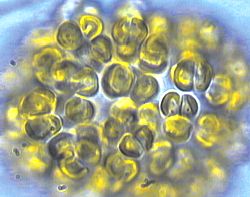
Chrysophyceae
Pyrrophytes/Dinoflagellates
Pyrrophytes are unicellular, photosynthetic, and mostly aquatic.They have protective coatsThey are more easily identifiable, due to the presence of two flagellae. The longer flagellae propels the dinoflagellate, while the second shorter, flatter flagellae functions as a rudderSome species of pyrrophytes are zooxanthellae. Since they lack cellulose plates, they make their home in coral reefs and animals, such as sea anemones, and molluscs. In returning the favour of sheltering them, dinoflagellates provide carbohydrates to their host through photosynthesis. This is why there are nutrient-rich coral reefs in malnutritions waterA negative aspect of pyrrophytes is that under certain conditions, species of dinoflagellates reproduce rapidly to form a harmful algal bloom (HAB), known as a red tide if dinoflagellates are the cause.Such pyrrophytes can produce toxins which may injure or kill wildlife, and additionally any consumers of contaminated wildlifeUnicellularCovered by stiff platesHave two flagellaMay glow in the darkFound in the ocean

Dinophyceae
Euglenophytes/Euglenoids
Like pyrrophytes, euglenophytes are small unicellular freshwater organisms with two flagellaMainly autotrophic or heterotrophic, depending if they have a red, light-sensitive structure called an eyespotAutotroph when sunny, Heterotrophs when dark UnicellularFound mostly in fresh waterHave a flagella
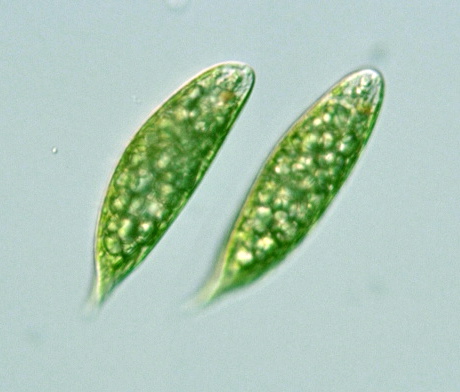
Euglena Proxima
Fungus-Like
Fungus-like protists share many features with fungiLike fungi, they are heterotrophs, meaning they must obtain food outside themselvesThey also have cell walls and reproduce by forming spores, just like fungiFungus-like protists usually do not move, but a few develop movement at some point in their livesTwo major types of fungus-like protists are slime molds and water molds
Oomycetes (Water Molds)
Oomycotes are filamentous organisms which resemble fungi, in that they live as saprotrophs.Live in water or moist environmentsLook like tiny threads with a fuzzy coveringAttack food: potatoes, cabbage, cornResponsible for Irish Potato FamineOomycotes differ from other moulds with the presence of spores and their sexual life cycle.

Leptomitales
Myxogastria (Acellular Slime Molds)
Myxogastria are plasmodial slime molds, although they were previously thought to be fungi. They produce fruiting bodies that resemble those created by higher fungi. They live in moist soil and on decaying plants and treesVery colorfulMove by forming pseudopodsFeed on bacteria and other microorganismsVisible to the naked eye as tiny slug-like organisms which creep over decayed and dead matterThis streaming blob containing many nuclei is called a plasmodium
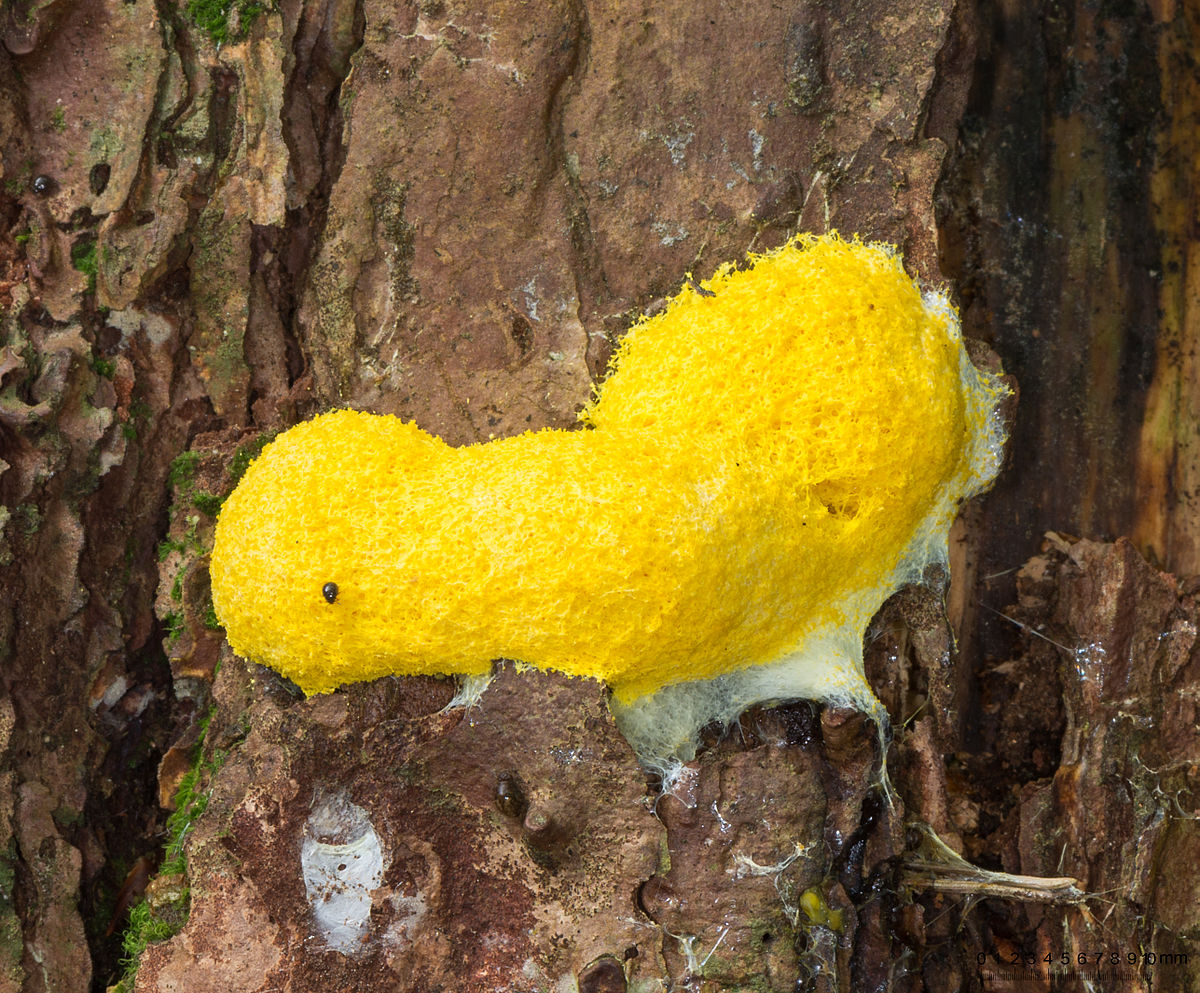
Fuligo septica
Cellular Slime Molds
Amoeba-like cellsEngulf bacteria (Like Amoebas)No flagellaCell wall made of celluloseAggregate (Form) into a plant like bud

Dictyostelium discoideum
Fungi
Fungi play key role in ecosystem; recycle organic material, cause disease, typically the first organism to enter a new environment and play a key role in soil ecosystems (With trees)Fungi are special because they have to obtain food; they do not produce their own food. Some act as parasites and feed on living things which usually cause some harm. They use enzymes to break down tissues.characteristics include being eukaryotic, chemoheterotrophic (Can't produce their own food and need to absorb it), they reproduce through spores, they are both sexual and asexual, they usually are not motile, they have cell walls composed of chitinThey have alternation of generationsFungi go through asexual reproduction.They form spores which are produced by special modified cells at the end of hyphaeFragmentation: if hyphae are broken the pieces will grow into complete new organismsAlso go through sexual reproductionEach of the four divisions (Or phyla) of fungi have different forms of sexual reproduction. One of the defining characteristics
Zygomycota
Common mould (Bread mould)(Conjugated FungiWhen the zygospore germinates, it undergoes meiosis and produces haploid spores, which will, in turn, grow into a new organism. This form of sexual reproduction in fungi is called conjugationSpreads over the surface of bread and other food sources, sending hyphae inward to absorb nutrientsIn its asexual phase it develops black sporangia at the tips of upright hyphae, each containing hundreds of haploid sporesSexual reproduction in occurs when haploid hyphae of different mating types are in close proximity to each otherGrowth of the gametangia commences after gametangia come in contact, and plasmogamy, or the fusion of the cytoplasm, occursWhen food is abundant, the zygote fungi often reproduce asexually with haploids, when conditions are limited they reproduce sexually Sexual reproduction produces resistance structures known as zygosporganim which can tolerate long periods of drying or freezing. Group is named for this unique reproductive structure.

Mucorales
Ascomycota
Sac-FungiA division or phylum of the kingdom Fungi that, together with the Basidiomycota, form the subkingdom Dikarya.Ascomycota are morphologically diverse.Ascomycota have two methods of reproduction: asexual and sexual. In asexual reproduction, the fungus undergoes budding or fission, where cells from the fungus divide and split, forming new, genetically identical fungi that can then break off and grow on their own. All Ascomycota fungi can reproduce sexually. In fact, the ascus, a sac-shaped cell formed as part of the sexual reproduction process, is what gives this group its name. In sexual reproduction, two different gametes, or sex cells, have to combine for reproduction to begin. In some species, the second gamete has to come from another fungus. In other species, a single fungus contains both male and female gametes and can self-fertilize.Reproduce both sexually & asexually.Wide-Range

Sordariomycetes
Basidiomycota
Club Fungi (Mushrooms, Club fungi)-Reproduce sexually with club shaped ends and some can reproduce asexuallyReproduce sexually via the formation of specialized club-shaped end cells called basidia that normally bear external meiospores (haploid spores). These specialized spores are called homosapiomedasin. However, some Basidiomycota reproduce asexually in addition or exclusively. Basidiomycota that reproduce asexually can be recognized as members of this division by gross similarity to others, by the formation of a distinctive anatomical feature, cell wall components, and definitively by molecular analysis of DNA sequence data.Sexual reproduction in Basidiomycota takes place in the fruiting body, in specialized structures called basidia.

Crucibulum vulgare
Deuteromycota
Imperfect fungi (Parasitic, Penicillum, fungi that cause disease)The fungi imperfecti or imperfect fungi, also known as Deuteromycota, are fungi which do not fit into the commonly established taxonomic classifications of fungi that are based on biological species concepts or morphological characteristics of sexual structures because their sexual form of reproduction has never been observed. Only their asexual form of reproduction is known, meaning that these fungi produce their spores asexually, in the process called sporogenesis.

Penicillium chrysogenum
Chytridiomycota
Chytridiomycota is a division of zoosporic organisms in the kingdom Fungi, informally known as chytrids. The name is derived from Greek and means "little pot", describing the structure containing unreleased zoosporesReproduce with zoosporeszoospore is a motile asexual spore that uses a flagellum for locomotion

Batrachochytrium dendrobatidis
Infamous for infecting and killing many amphibians
Glomeromycota
obligate symbiontsformation of arbuscules in plant rootslarge, multinucleate (eukaryotic cells that have more than one nucleus per cell) spores with layered wallsnon-septate hyphae
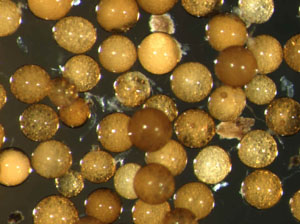
Scutellospora castanea
Animals
Though there is great diversity in the animal kingdom, animals can be distinguished from the other kingdoms by a set of characteristics. Though other types of life may share some of these characteristics, the set of characteristics as a whole provide a distinction from the other kingdoms. The set of characteristics provided by Audesirk and Audesirk are: Defining Characteristics:Animals are multicellular.Animals are heterotrophic, obtaining their energy by consuming energy-releasing food substances.Animals typically reproduce sexually.Animals are made up of cells that do not have cell walls.Animals are capable of motion in some stage of their lives.Animals are able to respond quickly to external stimuli as a result of nerve cells, muscle or contractile tissue, or both.
Crustacea
Characterized by having mandibles and compound eyes, biramous appendages (dividing to form two branches) and living in mostly aquatic habitats. There are some exceptions.
Malacostra
They are abundant in all marine environments and have colonised freshwater and terrestrial habitats. They are segmented animals, united by a common body plan comprising 20 body segments (rarely 21), and divided into a head, thorax, and abdomen.Contains a greater diversity of body forms than any other class in the animal kingdom

Crab
Maxillopoda
Maxillopoda is a diverse class of crustaceans including barnacles, copepods and a number of related animals. It does not appear to be a monophyletic group, and no single character unites all the members.

Barnacle
Branchiopoda
Members of the Branchiopoda are unified by the presence of gills on many of the animals' appendages, including some of the mouthparts. This is also responsible for the name of the group. They generally possess compound eyes and a carapace, which may be a shell of two valves enclosing the trunk (as in most Cladocera), broad and shallow (as in the Notostraca), or entirely absent (as in the Anostraca). In the groups where the carapace prevents the use of the trunk limbs for swimming (Cladocera, clam shrimp and the extinct Lipostraca), the antennae are used for locomotion, as they are in the nauplius.GillsCompound Eyes & Carapace

Water flea
Ostracoda
bodies are flattened from side to side and protected by a bivalve-like, chitinous or calcareous valve or "shell". The hinge of the two valves is in the upper (dorsal) region of the body. Ostracods are grouped together based on gross morphology, but the group may not be monophyletic; their molecular phylogeny remains ambiguous.Ecologically, marine ostracods can be part of the zooplankton or (most commonly) are part of the benthos, living on or inside the upper layer of the sea floor. Many ostracods, especially the Podocopida, are also found in fresh water, and terrestrial species of Mesocypris are known from humid forest soils of South Africa, Australia and New Zealand. They have a wide range of diets, and the group includes carnivores, herbivores, scavengers and filter feeders.
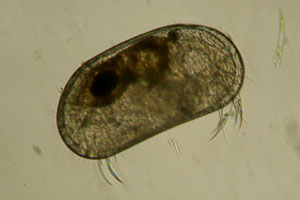
Podocopida (Known as Seed
Shrimp)
Hexapoda
Defining CharacteristicsBody divided into head, thorax, abdomen;uniramous appendages; one pair of antennae;Three pairs of walking legs; most with wings;Two pairs of mouthparts: mandibles and maxillaeMost insects possess wings as adults, also attached to the thorax;Undergo Metamorphosis growing from larva to adultThe appendages of arthropods may be either biramous or uniramous. A uniramous limb comprises a single series of segments attached end-to-end. A biramous limb, however, branches into two, and each branch consists of a series of segments attached end-to-end.
Non Insect Classes
Protura
Proturans have no eyes, wings, or antennae, and, lacking pigmentation, are usually white or pale brown. The sensory function of the antennae is fulfilled by the first of three pairs of five-segmented legs, which are held up, pointing forward and have many tarsal sensilla and sensory hairs. They walk with only four legs. The head is conical, and bears two pseudoculi with unknown function. The body is elongated and cylindrical, No eyes, wings or antennae, lacking pigmentSensory Function is with first 3 pairs of legs Walk on 4 legsConical head Body is cylindrical

Proturans
The Protura, or proturans, and sometimes nicknamed coneheads, are very small, soil-dwelling animals, so inconspicuous they were not noticed until the 20th century. The Protura constitute an order of hexapods that were previously regarded as insects, and sometimes treated as a class in their own right
Collembola
Members of Collembola are normally less than 6 mm (0.24 in) long, have six or fewer abdominal segments and possess a tubular appendage (the collophore or ventral tube) with eversible sticky vesicles, projecting ventrally from the first abdominal segment. The Poduromorpha and Entomobryomorpha have an elongated body, while the Symphypleona and Neelipleona have a globular body. Collembola lack a tracheal respiration system, which forces them to respire through a porous cuticle, to the notable exception of Sminthuridae which exhibit a rudimentary, although fully functional, tracheal system.[Six of less abdominal segmentsTubular appendageElongated or globular body

Springtail
Springtails are very small insects that jump around when disturbed, much like fleas. When the insect is disturbed, the furcula is released causing the insect to be flung into the air.Springtails form the largest of the three lineages of modern hexapods that are no longer considered insects.
Diplura
Diplurans are mostly 2–5 millimetres long, although some species of Japyx may reach 50 mm. They have no eyes and, apart from the darkened cerci in some species, they are unpigmented. They have long antennae with 10 or more bead-like segments projecting forward from the head, and a pair of cerci projecting backwards from the last of the 11 abdominal somites. These cerci may be long and filamentous or short and pincer-like, leading to occasional confusion with earwigs. These cerci give the group its name, from the Greek diplo ("two") and uros ("tail")No eyes apart from darkened cerci in someLong antennaeLots of body segmentsCerci (singular cercus) are paired appendages on the rear-most segments of many arthropods, including insects and symphylans. These would be the long rod like structures near the end of the arthropod

Two-pronged bristletails
The order Diplura is one of the four groups of hexapods, alongside insects, Collembola (springtails) and Protura. They are sometimes called "two-pronged bristletails".Eat dead matter
Insecta (Class 6)
Defining CharacteristicsTracheated arthropods. (having tracheae as breathing organs)It possesses 3 pairs of jointed legs.Body is segmented.Insect body is divided into 3 regions (head, thorax and abdomen) It possesses a pair of compound eyes & antennae.Two pairs of wings are present in adult stage.Trachea - a large membranous tube reinforced by rings of cartilage, extending from the larynx to the bronchial tubes and conveying air to and from the lungs; the windpipe. (Definition uses human body to define it)

Mantodea
Mantids

Blattodea
Cockroaches and Termites

Hymenoptera
Ants, Bees, Wasps and Sawflies
Chelicerate
Characterized byFour pairs of appendages are used for walking and two (the chelicerae and the pedipalps) are used as mouth parts. Chelicerates have no mandibles and no antennae six pairs of appendages
Pycnogonida
Defining Characteristics Include small sea spiders Exclusively marine formsLong legs with small body Body consists of a cephalothroax and abdomen Small abdomenAbdomen usually has no appendagesEyes present that are dorsally located Simple eyesFour pairs of walking legs, five or six paired are also present Single celled muscle system which is surrounded by connective tissue

Nymphon (Sea Spider)
Nymphon is a genus of sea spiders in the family Nymphonida
Merostomata
Defining Characteristics Marine aquatic formsProsoma with six appendage pairsOne pair of legs forms cheliciareFour pairs of legs that form the walking legs eyesCompound with flateral median ocellusRespiration by book gills
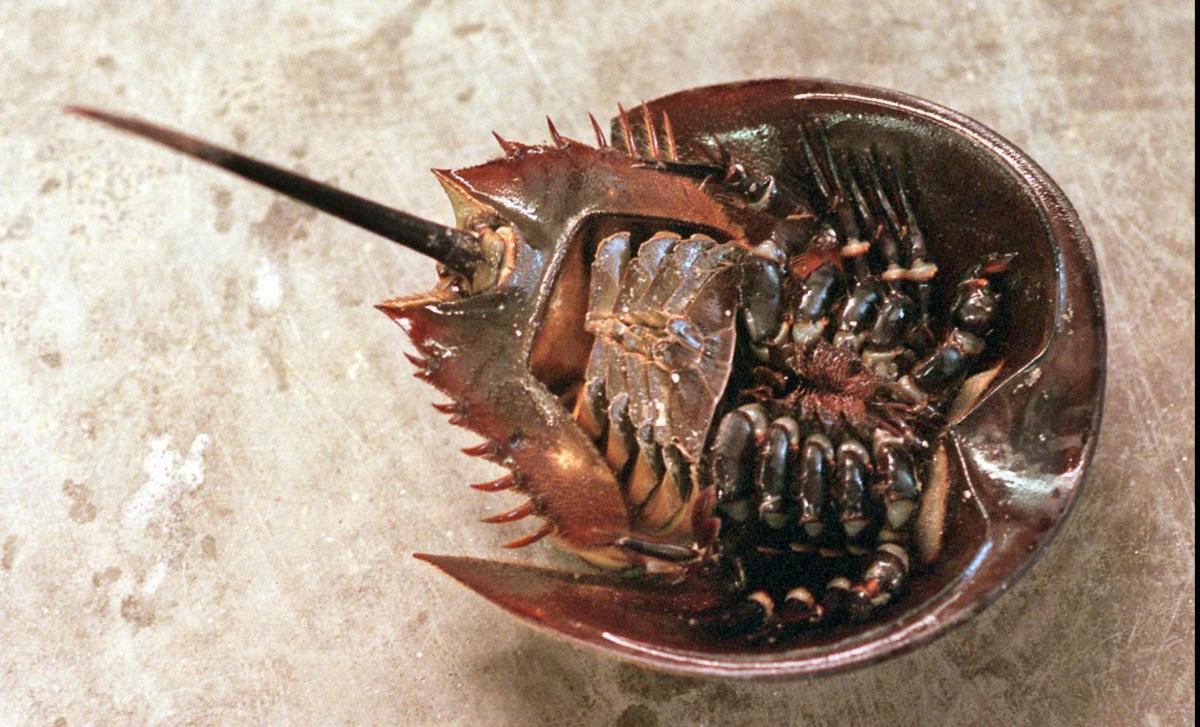
Horseshoe crabs
Horseshoe crabs are marine and brackish water arthropods of the family Limulidae, suborder Xiphosurida, and order Xiphosura. Their popular name is actually a misnomer, for they bear little resemblance to horseshoes, and they are not true crabs.
Arachnida
Arachnids – a class within the Chelicerates Spiders, mites, ticks, and scorpionsCharacterized byHaving two body segments, eight legs, and no antennae or wingsdo not go through metamorphosis but hatch from eggs as miniature adults (Molt to larger sizes)

Scorpions
Scorpions are predatory arachnids of the order Scorpiones. They have eight legs and are easily recognized by the pair of grasping pedipalps and the narrow, segmented tail, often carried in a characteristic forward curve over the back, ending with a venomous stinger.
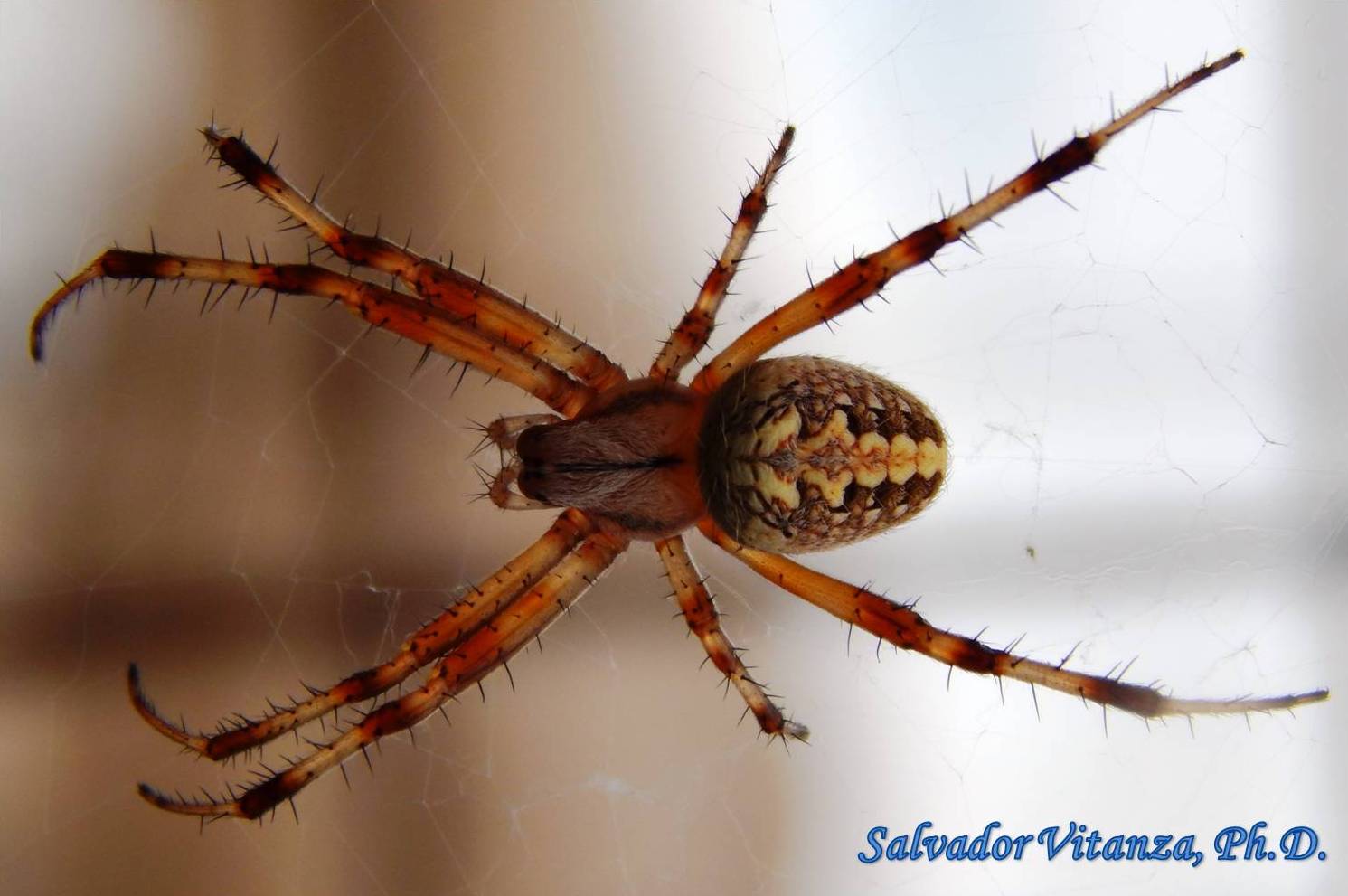
Araneae
Araneae are air-breathing arthropods that have eight legs and chelicerae with fangs able to inject venom. They are the largest order of arachnids and rank seventh in total species diversity among all other orders of organisms

Acari
Acari are a taxon of arachnids that contains mites and ticks. The diversity of the Acari is extraordinary and its fossil history goes back to at least the early Devonian period. Acarologists have proposed a complex set of taxonomic ranks to classify mites.
Myriapoda
Defining Characteristics Many pairs of legsTwo body sections (head and trunk)One pair of antennae on the headSimple eyesMandibles and maxillaeRespiratory exchange occurs through a tracheal system
Chilopoda
Defining Characteristics 1 pair of legs per body segment1 pair of poison claws/fangs underneath the headAntennae presentSimple eyes

Centipedes
Centipedes are arthropods belonging to the class Chilopoda of the subphylum Myriapoda, an arthropod group which also includes Millipedes and other multi-legged creatures. Centipedes are elongated metameric creatures with one pair of legs per body segment.
Diplopoda
Defining Characteristics They includes millipedes (Thousand legged worms)Terrestrial habitatDetritivorous feedersFeeds on decaying plant materialsBody is divided into head, thorax and abdomen they are dignathic with mandibles and gnathochilarium Gnathochilarium is the chewing (masticatory) organGnathochilarium is formed by the fusion of second maxillaeTrunk segments are diplosegmentic (Diplosegmentic = formed by the fusion of two segments during embryonal development)Each diplosegment bears two pairs of legs and two pairs of spiracles Respiration is by tracheaeExcretion is by malpighian tubulesThey are progoneate (Progoneate = single genital aperture opens in the anterior part of the trunk)

Millipedes
Millipedes are a group of arthropods that are characterised by having two pairs of jointed legs on most body segments; they are known scientifically as the class Diplopoda, the name being derived from this feature. Each double-legged segment is a result of two single segments fused together.
Symphyla
Defining Characteristics Commonly called garden centipedes or pseudo-centipedes Looks similar to centipedesTerrestrial soil dwelling arthropodsHerbivorous detritus feedersThey are translucent, lack body pigmentationBody is divided into head and trunkJuveniles have six pairs of legsAdditional legs are added at each moultEyes absentAntennae (sense organ) is long and segmented Three pairs of mouth partsThe have labium similar to insectsMandibles, long first maxillae and second pair of maxillae form the labium (lower lip of mouth)Last body segment (Back) lack legsLast body segment processes a pair of cerci (similar to insects)

Symphylans
Symphylans, also known as garden centipedes or pseudocentipedes, are soil-dwelling arthropods of the class Symphyla in the subphylum Myriapoda. Symphylans resemble centipedes, but are smaller and translucent, and only distantly related to true centipedes.
Pauropoda
Small group of centipede like arthropodsTerrestrial, live in the soilLook similar to centipedes, but they are ancestrally closer to millipedesSoft cylindrical body Number of legs increases with each moltEyes & heart are absentBody segments have ventral tracheal/spiracular pouches Tracheae absent Antennae are branched

Pauropodans
Pauropods are small, pale, millipede-like arthropods. Around 830 species in twelve families are found worldwide, living in soil and leaf mould. They look rather like centipedes, but are probably the sister group to millipedes. The name is derived from the Greek roots pauro "few" and podo "foot".
